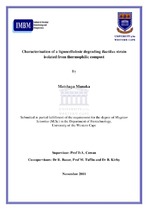| dc.contributor.advisor | Cowan, D.A | |
| dc.contributor.advisor | Bauer, R | |
| dc.contributor.advisor | Tuffin, M | |
| dc.contributor.advisor | Kirby, Bronwyn | |
| dc.contributor.author | Munaka, Matshaya | |
| dc.date.accessioned | 2017-03-14T15:01:31Z | |
| dc.date.available | 2017-03-14T15:01:31Z | |
| dc.date.issued | 2011 | |
| dc.identifier.uri | http://hdl.handle.net/11394/5373 | |
| dc.description | >Magister Scientiae - MSc | en_US |
| dc.description.abstract | The negative environmental impact of fossil fuels and growing concerns about petroleum supplies has driven the search for alternative, renewable transportation fuels. An 'ideal' fuel replacement would be a biofuel produced from lignocellulosic biomass. Unfortunately, the presence of lignin in plant cell walls impedes the breakdown of cell wall polysaccharides into simple sugars and the subsequent conversion of these sugars into useable fuels. One of the most common fates of lignin in nature is to be metabolized by lignin peroxidases (LiPs), predominantly of microbial origin. This study aims to isolate and characterise microorganism(s) involved in the degradation of lignocellulose. Thermophilic bacteria were isolated from straw-based compost and screened for lignin peroxidase activity. One isolate, CP11, showed significant lignin peroxidase activity and based on 16S rRNA gene sequence analysis, the isolate was found to be most closely related to Bacillus thermoamylovorans. Morphological, physiological and biochemical characterisation was conducted to determine whether the isolate was a novel species. Morphologically, CP11 was characterised as an endospore-forming, Gram positive rod. In addition, the isolate was found to be a facultative anaerobe, catalase positive and capable of utilising a range of carbon sources including glucose, sucrose and arabinose. Isolate CP11 was moderately thermotolerant and grew between 37°C and 55°C, with an optimum growth temperature of 45°C. Based on its phenotypic characteristics CP11 could be clearly distinguished from its closest phylogenetic neighbours. Preliminary characterisation of the lignin peroxidase was conducted using crude enzyme extract and Azure B dye as the substrate. Activity was detected in the supernatant only and a growth curve was constructed to determine the growth phase of lignin peroxidase production. In order to identify the gene encoding the lignin peroxidase a small insert library was constructed and screened for ligninase activity using Azure B as the substrate. | en_US |
| dc.description.sponsorship | National Research Foundation | en_US |
| dc.language.iso | en | en_US |
| dc.publisher | University of the Western Cape | en_US |
| dc.subject | Lignin | en_US |
| dc.subject | Lignocellulose | en_US |
| dc.subject | Thermophilic bacteria | en_US |
| dc.subject | Biofuels | en_US |
| dc.subject | Lignin peroxidases (LiPs) | en_US |
| dc.title | Characterisation of a lignocellulosic degrading bacillus strain isolated from thermophilic compost | en_US |
| dc.rights.holder | University of the Western Cape | en_US |

